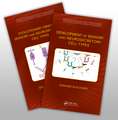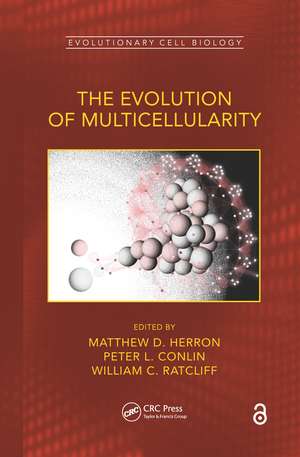The Evolution of Multicellularity: Evolutionary Cell Biology
Editat de Matthew D. Herron, Peter L. Conlin, William C. Ratcliffen Limba Engleză Paperback – 26 aug 2024
Chapter 13 of this book is freely available as a downloadable Open Access PDF at http://www.taylorfrancis.com under a Creative Commons Attribution-Non Commercial-No Derivatives (CC-BY-NC-ND) 4.0 license.
| Toate formatele și edițiile | Preț | Express |
|---|---|---|
| Paperback (1) | 436.14 lei 6-8 săpt. | |
| CRC Press – 26 aug 2024 | 436.14 lei 6-8 săpt. | |
| Hardback (1) | 1326.99 lei 6-8 săpt. | |
| CRC Press – 8 iun 2022 | 1326.99 lei 6-8 săpt. |
Din seria Evolutionary Cell Biology
- 9%
 Preț: 834.95 lei
Preț: 834.95 lei - 8%
 Preț: 511.81 lei
Preț: 511.81 lei - 9%
 Preț: 640.84 lei
Preț: 640.84 lei -
 Preț: 387.70 lei
Preț: 387.70 lei -
 Preț: 371.71 lei
Preț: 371.71 lei - 12%
 Preț: 328.19 lei
Preț: 328.19 lei - 13%
 Preț: 309.63 lei
Preț: 309.63 lei - 25%
 Preț: 630.90 lei
Preț: 630.90 lei - 18%
 Preț: 793.01 lei
Preț: 793.01 lei - 11%
 Preț: 320.10 lei
Preț: 320.10 lei - 25%
 Preț: 768.64 lei
Preț: 768.64 lei - 25%
 Preț: 1224.08 lei
Preț: 1224.08 lei -
 Preț: 456.06 lei
Preț: 456.06 lei - 14%
 Preț: 314.24 lei
Preț: 314.24 lei - 25%
 Preț: 827.09 lei
Preț: 827.09 lei
Preț: 436.14 lei
Nou
Puncte Express: 654
Preț estimativ în valută:
83.46€ • 86.61$ • 69.76£
83.46€ • 86.61$ • 69.76£
Carte tipărită la comandă
Livrare economică 15-29 martie
Preluare comenzi: 021 569.72.76
Specificații
ISBN-13: 9781032207797
ISBN-10: 1032207795
Pagini: 400
Ilustrații: 110
Dimensiuni: 156 x 234 x 22 mm
Greutate: 0.45 kg
Ediția:1
Editura: CRC Press
Colecția CRC Press
Seria Evolutionary Cell Biology
Locul publicării:Boca Raton, United States
ISBN-10: 1032207795
Pagini: 400
Ilustrații: 110
Dimensiuni: 156 x 234 x 22 mm
Greutate: 0.45 kg
Ediția:1
Editura: CRC Press
Colecția CRC Press
Seria Evolutionary Cell Biology
Locul publicării:Boca Raton, United States
Public țintă
Academic, Postgraduate, and ProfessionalNotă biografică
Matthew D. Herron is a Senior Research Scientist in the School of Biology at the Georgia Institute of Technology. He received his PhD from the University of Arizona and held postdoctoral positions at the University of British Columbia, the NASA Astrobiology Institute, and the University of Montana. He has authored or co-authored dozens of peer reviewed scientific papers.
William C. Ratcliff is an Associate Professor in School of Biological Sciences at the Georgia Institute of Technology, where he co-directs the Interdisciplinary Graduate Program in Quantitative Biosciences. He received his PhD from the University of Minnesota. At Tech, he leads a research group that examines the evolution of multicellularity through directed evolution, synthetic biology, and mathematical modeling.
Peter L. Conlin is a Postdoctoral Researcher in the School of Biological Sciences at the Georgia Institute of Technology. He received his PhD from the University of Washington. He has authored or co-authored several peer reviewed scientific papers.
William C. Ratcliff is an Associate Professor in School of Biological Sciences at the Georgia Institute of Technology, where he co-directs the Interdisciplinary Graduate Program in Quantitative Biosciences. He received his PhD from the University of Minnesota. At Tech, he leads a research group that examines the evolution of multicellularity through directed evolution, synthetic biology, and mathematical modeling.
Peter L. Conlin is a Postdoctoral Researcher in the School of Biological Sciences at the Georgia Institute of Technology. He received his PhD from the University of Washington. He has authored or co-authored several peer reviewed scientific papers.
Cuprins
Foreword by Andrew H. Knoll. Acknowledgments. List of Contributors. Introduction: The Evolution of Multicellularity in Context. Getting at the Basics of Multicellularity. Multi-Level Selection of the Individual Organism. Life Cycles as a Central Organizing Theme for Studying Multicellularity. Eukaryote Aggregative Multicellularity: Phylogenetic Distribution and a Case Study of Its Proximate and Ultimate Cause in Dictyostelia. Group Formation: On the Evolution of Aggregative Multicellularity. Group Maintenance in Aggregative Multicellularity. Group Transformation: Fruiting Body and Stalk Formation. Phylogenetics of Clonal Multicellularity. Group Formation: Hypotheses for the Evolution of Clonal Multicellularity. Group Maintenance in Clonal Multicellularity: Controlling Intra-organismal Evolution. Group Transformation: Life History Trade-offs, Division of Labor, and Evolutionary Transitions in Individuality. The Single-Celled Ancestors of Animals: A History of Hypotheses. Convergent Evolution of Complex Multicellularity in Fungi. Genetic and Developmental Mechanisms of Cellular Differentiation in Algae. The Evolution of Complex Multicellularity in Streptophytes. Multi-Species Multicellular Life Cycles. Conclusion: The Future of Multicellularity Research. Index.
Recenzii
The emergence of multicellular organisms is one of the most striking transitions in evolution. This nicely illustrated volume covers this topic from many angles, with 18 chapters by outstanding researchers in this fascinating and productive field. – Richard Lenski, Michigan State University
No major transition was more major than that from single-celled to multicellular life. The editors of and contributors to The Evolution of Multicellularity do a wonderful job walking the reader through that transition. I heartily recommend this book to (multicellular) readers everywhere. – Lee Dugatkin, University of Louisville
The new volume, The Evolution of Multicellularity edited by M.D. Herron et al., pulls together current thought on multicellularity from workers across a constellation of fields. This volume does a wonderful job covering the issues: from how to recognize multicellularity (Chapter 2), multilevel selection (Chapter 3), to multicellularity in fungi (Chapter 14), algae, and plants (Chapters 15 and 16). – Carl Simpson, Trends in Ecology & Evolution
No major transition was more major than that from single-celled to multicellular life. The editors of and contributors to The Evolution of Multicellularity do a wonderful job walking the reader through that transition. I heartily recommend this book to (multicellular) readers everywhere. – Lee Dugatkin, University of Louisville
The new volume, The Evolution of Multicellularity edited by M.D. Herron et al., pulls together current thought on multicellularity from workers across a constellation of fields. This volume does a wonderful job covering the issues: from how to recognize multicellularity (Chapter 2), multilevel selection (Chapter 3), to multicellularity in fungi (Chapter 14), algae, and plants (Chapters 15 and 16). – Carl Simpson, Trends in Ecology & Evolution
Descriere
This book examines the origins and subsequent evolution of multicellularity. The transition from unicellular to multicellular life was one of a few major events in the history of life that created new opportunities for more complex biological systems to evolve.
